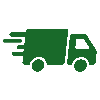
Bleeding Heart
-
Pink, Red

Color
-
Spring

Season
-
12-16 inches

Height
-
3-9

Zone
-
Bare Root/Plug

Ships
-
Full Sun, Partial Shade

Exposure
Description
Description
Old Fashioned Bleed Heart
The bleeding heart (Dicentra spectabilis) is a popular perennial plant known for its unique and attractive appearance. It is native to parts of Asia and North America and is often grown for its distinctive, heart-shaped flowers. Here are some critical details about bleeding heart perennials:
- Heart-shaped flowers: The name "bleeding heart" is derived from the flower's shape, which resembles a heart with a drop of "bleeding" at the bottom. The flowers typically have two outer petals in shades of pink, red, or white that form the outer heart shape and a smaller inner petal that appears to be "bleeding."
- Foliage: Bleeding hearts have delicate, fern-like, and finely divided foliage that adds to their charm. The leaves are typically green or bluish-green.
- Growing conditions: Bleeding hearts thrive in partial to full shade and prefer moist, well-drained soil. They are suitable for woodland gardens or shaded borders. In regions with hot summers, they may benefit from some protection from the harsh midday sun.
- Blooming period: Bleeding hearts typically bloom in late spring to early summer. The flowers are borne on arching stems and can persist for several weeks.
- Height and spread: Depending on the variety, bleeding heart plants can reach heights of 1 to 3 feet (30 to 90 cm) and have a similar spread.
- Varieties: There are several bleeding heart species and cultivars, each with unique characteristics. Some popular cultivars include Dicentra spectabilis 'Alba' (white flowers), Dicentra spectabilis 'Gold Heart' (golden foliage), and Dicentra spectabilis 'Valentine' (deep red flowers).
- Maintenance: Bleeding hearts are relatively low-maintenance perennials. They benefit from regular watering to keep the soil consistently moist, especially during dry spells. Mulching can help retain soil moisture. Pruning the plant after it has bloomed can promote healthy growth and reduce disease risk.
- Winter care: In colder climates, mulching and providing some winter protection can help protect the plant's roots from harsh winter conditions.
Bleeding hearts are beloved for their whimsical and romantic appearance, making them a popular choice in gardens and landscapes. They are also deer-resistant, which can be a valuable feature for gardeners dealing with deer browsing issues.
Bleeding hearts (Dicentra spectabilis) are beautiful perennial plants that produce unique, heart-shaped flowers. Caring for bleeding hearts involves providing the right growing conditions and proper maintenance. Here are some tips on how to care for your bleeding heart plant:
- Planting:
- Please choose a suitable location: Bleeding hearts prefer partial to full shade, although they can tolerate morning sun. They thrive in well-draining, humus-rich soil that retains moisture but does not become waterlogged.
- Watering:
- Keep the soil moisturized: Water your bleeding heart regularly, especially during dry spells. These plants prefer evenly moist soil but do not tolerate standing water. Mulch around the base of the plant to help retain moisture and suppress weeds.
- Fertilizing:
- Fertilize in early spring: Use a balanced, slow-release fertilizer or organic compost to feed your bleeding heart plant when it begins to emerge in early spring.
- Pruning:
- Deadhead spent flowers: After the initial spring bloom, trim off the faded flowers to encourage a potential second flush of growth and blooms. In late fall or early winter, cut back the foliage to the ground as the plant goes dormant.
- Pests and Diseases:
- Keep an eye out for pests and diseases: While bleeding hearts are generally resilient, they can be susceptible to slugs and snails. You may need to take steps to control these pests if they become a problem. Additionally, good air circulation and proper spacing can help prevent fungal diseases.
- Winter Care:
- In areas with harsh winters, apply a layer of mulch or compost to protect the plant during cold months. This extra layer will help insulate the roots and prevent them from freezing.
- Division:
- Bleeding hearts tend to become crowded over time. You can divide mature plants every 3-4 years in the spring or fall to rejuvenate and create new plants. Dig up the clump, separate it into smaller sections, and replant them.
- Support:
- As bleeding heart plants grow, they can become top-heavy and may benefit from staking or other support to prevent them from flopping over.
By following these care guidelines, you can enjoy the beauty of your bleeding heart plant for many years. Remember that while bleeding hearts can be resilient, they still benefit from regular attention and maintenance to ensure their health and longevity.
FAQ
1. Do bleeding heart plants come back?
A. Yes, Bleeding Heart Plants (Dicentra species) are typically perennial, meaning they come back year after year. These plants are known for their unique and attractive flowers that resemble hearts with drops of "blood" hanging from them. Bleeding heart plants tend to go dormant in the winter, during which the foliage dies back and the plant appears to disappear.
2. Do Bleeding Hearts bloom all summer?
A. Bleeding Heart Plants typically bloom in late spring to early summer, and their blooming period doesn't extend throughout the entire summer. The flowers are charming but somewhat short-lived, with the blooming season usually lasting a few weeks.





